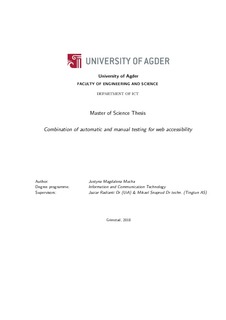| dc.description.abstract | Web accessibility is an indispensable medium for online communication and digital inclusion
nowadays. With the recent adoption of the Web Accessibility Directive making the Internet
resources accessible has become a legal obligation and strikes a need for more detailed and
reliable ways of web accessibility evaluation of the websites.
Throughout the years, many tools have been developed for testing web accessibility as well
as a plethora of metrics that are expected to convey the results. Unfortunately, in most cases
the findings appear to be incomplete since the studies rely only on one testing method, i.e.,
automatic or manual. The study has set itself a goal to contribute with knowledge to solving
three research questions. First, how to combine results from automated and manual evaluation
of web accessibility? Second, how to express the integration results in a quantitative manner?
Finally, what is the impact of the dynamic content on the integration results when the content
of the website is frequently updated and personalized?
This thesis proposes a novel approach to integration of manual and automated accessibility
testing, where the results of the evaluations are combined on the basis of accessibility guidelines.
Additionally, a quantitative metric – Union Score, together with a graphical visualization
called Accessibility Pie Chart, are propounded, as the means for expressing the outcomes of the
accessibility evaluation with use of the combined approach.
The research has been grounded on the mixed-method approach and embedded the findings
of the conducted interviews into a quantitative study. In order to find emphirically the most
suitable method for combining manual and automated testing, fifteen web pages selected from
two websites were chosen for evaluation with two testing tools: WTKollen Checker and WTKollen
User-Testing Tool.
The findings of the analysis show that WCAG 2.0 may serve as a bridge between manual and
automated evaluation outcomes and result in an increased coverage of the Success Criteria. The
proposed metric has been preliminarily validated with regard to its application for benchmarking
purposes and supplemented with a graphical way of presenting accessibility testing results.
Furthermore, it is concluded that the suggested integration approach can be deployed. Yet, the
challenge of dynamic content evaluation requires more research attention.
The study has contributed to the current state of knowledge about web accessibility evaluation
and the results are expected to be used for implementation of the novel approach. For the
future paths, a more extended study on the proposed metric’s properties is advised. Also, the
importance of further research in the area of dynamic content evaluation is highlighted. | nb_NO |

